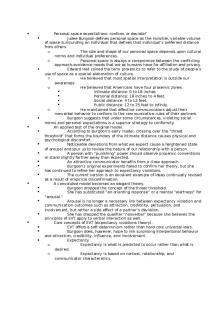Vroom’s Expectancy Theory PDF

| Title | Vroom’s Expectancy Theory |
|---|---|
| Author | Lhiza Jade Abanco |
| Course | Accounting |
| Institution | AAB University |
| Pages | 3 |
| File Size | 90.8 KB |
| File Type | |
| Total Downloads | 89 |
| Total Views | 143 |
Summary
Vroom’s Expectancy Theory. more discussion in this lecture...
Description
Vroom’s Expectancy Theory: One of the most widely accepted explanations of motivation is offered by Victor Vroom in his Expectancy Theory” It is a cognitive process theory of motivation. The theory is founded on the basic notions that people will be motivated to exert a high level of effort when they believe there are relationships between the effort they put forth, the performance they achieve, and the outcomes/ rewards they receive. The relationships between notions of effort, performance, and reward are depicted in Figure 17.3
Thus, the key constructs in the expectancy theory of motivation are: 1. Valence: Valence, according to Vroom, means the value or strength one places on a particular outcome or reward. 2. Expectancy: It relates efforts to performance. 3. Instrumentality: By instrumentality, Vroom means, the belief that performance is related to rewards.
Thus, Vroom’s motivation can also be expressed in the form of an equation as follows: Motivation = Valence x Expectancy x Instrumentality Being the model multiplicative in nature, all the three variables must have high positive values to imply motivated performance choice. If any one of the variables approaches to zero level, the possibility of the so motivated performance also touches zero level. However, Vroom’s expectancy theory has its critics. The important ones are: 1. Critics like Porter and Lawler lebeled it as a theory of cognitive hedonism which proposes that individual cognitively chooses the course of action that leads to the greatest degree of pleasure or the smallest degree of pain. 2. The assumption that people are rational and calculating makes the theory idealistic. 3. The expectancy theory does not describe individual and situational differences. But the valence or value people place on various rewards varies. For example, one employee prefers salary to benefits, whereas another person prefers to just the reverse. The valence for the same reward varies from situation to situation.
In spite of all these critics, the greatest point in me expectancy theory is that it explains why significant segment of workforce exerts low levels of efforts in carrying out job responsibilities....
Similar Free PDFs

Vroom’s Expectancy Theory
- 3 Pages

EXPECTANCY TEORY
- 31 Pages

Theory Worksheet
- 88 Pages

Labeling Theory
- 4 Pages

Particle Theory
- 2 Pages

Auditing theory
- 26 Pages

Grand Theory
- 18 Pages

Mydral\'s theory
- 2 Pages

Producer theory
- 7 Pages

Modernisation theory
- 15 Pages
Popular Institutions
- Tinajero National High School - Annex
- Politeknik Caltex Riau
- Yokohama City University
- SGT University
- University of Al-Qadisiyah
- Divine Word College of Vigan
- Techniek College Rotterdam
- Universidade de Santiago
- Universiti Teknologi MARA Cawangan Johor Kampus Pasir Gudang
- Poltekkes Kemenkes Yogyakarta
- Baguio City National High School
- Colegio san marcos
- preparatoria uno
- Centro de Bachillerato Tecnológico Industrial y de Servicios No. 107
- Dalian Maritime University
- Quang Trung Secondary School
- Colegio Tecnológico en Informática
- Corporación Regional de Educación Superior
- Grupo CEDVA
- Dar Al Uloom University
- Centro de Estudios Preuniversitarios de la Universidad Nacional de Ingeniería
- 上智大学
- Aakash International School, Nuna Majara
- San Felipe Neri Catholic School
- Kang Chiao International School - New Taipei City
- Misamis Occidental National High School
- Institución Educativa Escuela Normal Juan Ladrilleros
- Kolehiyo ng Pantukan
- Batanes State College
- Instituto Continental
- Sekolah Menengah Kejuruan Kesehatan Kaltara (Tarakan)
- Colegio de La Inmaculada Concepcion - Cebu





